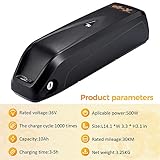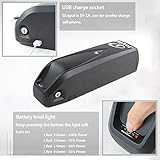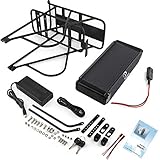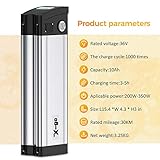Table of Contents
E-bike batteries ultimately determine how far and how long you can ride, and choosing the right one is essential for maximizing your bike’s performance and value.
Alongside the motor, the battery is arguably a critical (and maybe the most expensive) component of your ride, even with modern improvements and price drops.
Whether you’re powering the motor, controller, or lighting system, choosing the right power source ensures a smooth, efficient ride.
This quick snippet video has some important tips on care and long-term storage.
What to look for in an e-bike battery?
To make a smart decision, you’ll need to understand the core components that define an e-bike battery’s performance.
Capacity and power (voltage, amps, and watts)
What is “voltage (V)”?
Voltage represents the electric potential, essentially the “horsepower” pushing electricity to the motor. Most e-bike batteries come in 36V or 48V options, while 72V versions support higher-output motors. A 48V battery is a common standard for throttle-based bikes like the Super 73 S1 Fat Tire.
What is “Amps (Ah)”?
Amps refer to a measure of force, which is ultimately a measurement of the electrical current flowing from the battery; in turn, the Amp-hour rating refers to the battery’s capacity (see following item for more details).
For ebike batteries, the higher the amp-hours, the greater the distance you can travel.
What is “Watts (Wh)” in electric bicycles?
If voltage is the flow of energy and amps are the measure of the force, then watts (Wh) are a combination of the two.
Capacity is measured in watt-hours (Wh). Watt-hour equals the value of the “Ah” multiplied by the “V”; for example, a typical 36V, 10Ah battery has 360Wh. Batteries on Pedelec and S-Pedelec typically range from 250 to 650 Wh.
Quick Tip: While higher wattage can suggest a more extended range, real-world conditions like terrain, rider weight, and assist level greatly affect performance.
Size and Weight
The size and weight of your electric bike battery impact more than storage—they affect agility, range, and even comfort. Lightweight batteries tend to be more expensive but are ideal for city riders or commuters. Budget e-bikes, such as the Swagtron EB7 Plus, may come with heavier systems that are less efficient and durable.
According to e-bike manufacturers, modern batteries account for up to 30% of total bike weight, so it is always better to find a bike with a removable battery (if the bike is for touring or MBT).
How Far Can E-Bike Batteries Go?
Thanks to constant improvements, some e-bike batteries now claim up to 120 km (74 miles) per charge. However, expect variation based on:
- Rider weight
- Terrain
- Pedal assist level (PAS) used
- Temperature (batteries prefer mild cold to extreme heat)
Quick Tip: Look for waterproofing rather than water-resistant. High-end e-bikes offer waterproofing tech.
Types of e-Bike Battery Chemistry
There are three (3) types of batteries used for electric bikes: lead acid, Li-Ion (most popular), and Li-PO.
Lead Acid Batteries
It is cheap and heavy, and very rare to find these days; however, I have seen it in self-built e-bikes. Their short lifespan and poor performance make them an outdated option.
Verdict: Avoid if possible
Lithium-ion (Li-Ion) – The Most Popular
Used in 90% of modern electric bike batteries. These are efficient, long-lasting, and relatively lightweight.

Lithium-ion Polymer (Li-PO)
One of the newer options on the block, a lithium-ion polymer battery, is similar to Li-Ion but can be molded into just about any shape.
The non-rigid container enables manufacturers to integrate it into the frame’s shape and is reported to be less vulnerable to damage.
Although the information available about these types of batteries is limited, they could eventually take over the market.
For How Long Should I Leave an e-Bike Battery Charging?
Charging time for an electric bike battery depends on the manufacturer’s guidelines. It’s always important to read the instruction manual thoroughly before initiating the first charge.
The charging duration also varies based on battery type. Lead-acid batteries typically require more time, often over five (5) hours.
In contrast, lithium-ion batteries generally charge more quickly, usually within 3 to 5 hours, depending on their capacity and charger specifications.
What is the Ideal Lowest Voltage to Prevent Damage?
To maximize the lifespan and performance of your electric bike battery, avoid deep discharge cycles whenever possible. It’s recommended to maintain some charge in the battery rather than letting it fully deplete.
Although opinions vary, many experts advise keeping the charge level above 50% to prevent performance issues.
Some chargers may not activate if the battery drops below a certain cut-off threshold, often around 25%.
If you’re using lithium-ion chemistry, the BMS helps prevent overcharging and excessive discharge, which can extend the battery’s lifespan.
How Long Does an e-Bike Battery Last?
Premium batteries can last up to five (5) years, especially when combined with smart chargers and BMS technology.
Like all batteries, performance gradually declines over time due to natural degradation of the cell materials, even when not in use.
Battery warranties are often shorter than those for the bike’s other components.
Sleep Mode and BMS
Battery technology has advanced significantly, with many high-end models, like the one used in the Bianchi Aria e Road, featuring a “sleep mode.”
Sleep mode refers to a low-power state where the BMS protects the battery’s internal cells when not in use.
Connecting the battery to the bike or charger will automatically wake it from sleep mode.
Although you may be able to return the battery to sleep mode, its performance might not match that of before its first use.
If your battery has been idle for a while, it’s good practice to recharge it at least once annually to maintain functionality.
Smart chargers
Manufacturers have recognized that chargers significantly influence the longevity of electric bike batteries.
High-quality smart chargers automatically stop sending power once the battery reaches full charge. This feature helps prevent overcharging, even if the charger indicates the battery is still connected.
If your battery is in good condition, lithium-ion models can typically handle around 1,000 charge cycles. In contrast, lead-acid batteries often require replacement after 200–300 cycles.
E-Bike Batteries Care and Maintenance
While all e-bike batteries degrade with time, proper care can help extend their lifespan. Follow these best practices:
- Handle the battery gently—drops and excessive vibrations can reduce longevity.
- Store it indoors at a moderate temperature (between 20°C and 30°C), and avoid prolonged exposure to direct sunlight.
- Disconnect the battery as soon as it’s fully charged, regardless of battery type.
- Ensure your tires are properly inflated to reduce rolling resistance and improve overall efficiency.
- Monitor your motor’s performance and make sure all connected components are functioning well.
- If you experience issues with the battery early on, request a replacement while it’s still under warranty.
If problems persist, consider returning the entire electric bike for professional inspection.
SAFETY NOTE
NEVER POUR WATER ON A SMOKY, BROKEN, OR FAULTY BATTERY. THE CHEMICALS INSIDE WILL REACT TO IT.
Recommended Electric Bike Battery Suppliers
While generics can be functional, trusted brands offer better safety and longevity. Top battery suppliers include:
- LG
- Samsung
- Sanyo
- Panasonic
- Bosch
- Traxxas (Li-PO specialist)
Budget options: Joyisi, X-go, and Bespov.
Pro Tip: Look for certification marks like UL 2849, CE, or RoHS for added peace of mind.
Comparing E-Bike Battery Tech: 2024 vs. 2025
The past year has seen notable improvements in e-bike battery tech:
| Feature | 2024 | 2025 |
| Average Range | 40–50 miles (64-80km) | 50–75 miles (80 – 120 km) |
| Charging Speed | 3–5 hrs (Li-Ion) | Smart charging: down to 2.5–4 hrs |
| BMS Integration | Limited to mid-range & up | Now standard on most models |
| Waterproofing | Common in high-end models only | Expanded to mid-range bikes |
| Sleep Mode | Premium-only feature | More widespread |
| Battery Chemistry | Li-Ion, Li-PO emerging | No change |
| Sustainability Focus | Low recycling options | More recyclable materials & programs |
Guide Wrap Up
E-bike batteries are the heart of your electric ride. A well-chosen battery can give you years of performance, while a poorly matched one can cause frustration—or worse, safety risks.
If you’re after value, efficiency, and reliability, a lithium-ion alternative with a smart charger and BMS is the way to go. Match it carefully to your motor specs—and ride smart!
Are you looking to buy a budget battery?








